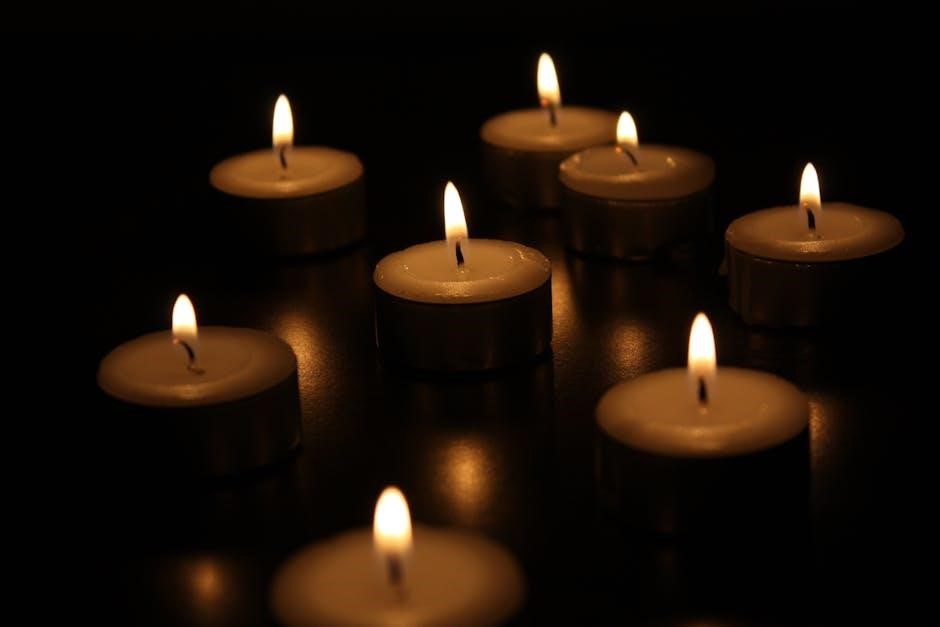
premier wick guide
Selecting the right wick is crucial for a candle’s performance. This premier guide helps you understand the basics, ensuring optimal burn and fragrance throw. Learn how wax type, vessel size, and fragrance load influence your choice, setting the foundation for creating perfect candles every time.
1.1 Importance of Choosing the Right Wick
Selecting the correct wick is vital for ensuring a clean, even burn and optimal fragrance release. A properly sized wick prevents issues like tunneling, soot formation, or a weak flame. It also enhances safety by maintaining consistent burning conditions. The wrong wick can lead to poor performance and potential fire hazards, making it essential to choose wisely for a satisfying and safe candle experience.
1.2 Overview of Wax and Wick Compatibility
Wax and wick compatibility is essential for a candle’s performance. Different waxes, such as soy, beeswax, and paraffin, require specific wicks to ensure proper burning. For instance, soy wax often pairs well with cotton or ECO wicks, while paraffin may need zinc-core wicks for stability. Compatibility ensures even burning, prevents soot, and maximizes fragrance throw, making it a critical factor in achieving a high-quality candle.
Types of Wicks
Cotton wicks offer a steady burn, zinc core wicks are durable for larger vessels, and ECO wicks each support eco-friendly candle-making with natural wax compatibility.
2.1 Cotton Wicks
Cotton wicks are a popular choice for candle-making, offering a steady, consistent burn. They are ideal for use with soy wax and other natural waxes, ensuring a clean and even flame. Cotton wicks are often recommended for beginners due to their reliability and versatility. They are also eco-friendly and widely available, making them a great starting point for testing different candle recipes and fragrance combinations.
2.2 Zinc Core Wicks
Zinc core wicks are durable and ideal for larger candles, providing a stable burn. They are commonly used in container and pillar candles, as they maintain an upright position. These wicks are suitable for soy and paraffin waxes, offering consistent performance. The zinc core ensures a straight burn, making them a reliable choice for achieving a clean, even flame in various candle applications.
2.3 ECO Wicks
ECO wicks are an eco-friendly option, typically made from natural materials like soy or cotton. They are recommended for soy wax candles, promoting a clean burn with minimal soot. These wicks are biodegradable and free from harmful chemicals, making them a sustainable choice. ECO wicks are versatile, suitable for container candles, and work well with paraffin wax too, offering a greener alternative for candle makers without compromising performance.
How to Choose the Best Wick for Your Candle
Selecting the ideal wick involves considering wax type, vessel size, and fragrance load. Testing different options ensures optimal burn performance and even fragrance distribution for your candle.
3.1 Wax Type and Wick Compatibility
Wax type plays a critical role in wick selection. Soy wax, for instance, pairs best with eco or cotton wicks, while paraffin wax often requires zinc core wicks for stability. Beeswax, being more challenging, may need extensive testing. Each wax type has specific wick recommendations to ensure a clean, even burn and optimal fragrance throw.
3.2 Vessel Size and Wick Diameter
Vessel size and wick diameter are closely linked to ensure proper burning. Larger containers require thicker wicks to maintain an even flame, while smaller vessels need slimmer wicks to prevent overheating. The wick’s diameter must balance the melt pool size, ensuring efficient fuel delivery. Incorrect sizing can lead to poor burn performance, such as tunneling or excessive soot. Always test wick sizes to find the optimal fit for your specific candle design.

Troubleshooting Common Wick Issues
Identify issues like uneven burns or excess soot. Adjust wick size for proper flame height. Test different diameters to ensure a clean, consistent burn. Optimize for performance.
4.1 Signs of an Incorrect Wick
- An uneven or flickering flame indicates a wick that’s too small or large.
- Excessive soot or smoke suggests poor wick-wax compatibility.
- A weak or dim flame may mean the wick is not absorbing enough wax.
- Pool of unburned wax around the wick edges signals improper sizing.
- Frequent relighting or a drowning wick points to a mismatch with the vessel size.
Addressing these signs ensures a cleaner, safer burn and better fragrance throw.
4.2 Adjusting Wick Size for Optimal Burn
Optimal burn performance requires precise wick sizing. Start with a wick slightly larger than recommended for your wax type and vessel size, then test and adjust. A wick too small may not melt the wax pool fully, while a wick too large can cause excessive soot or an unstable flame. Fine-tuning ensures a clean, even burn and maximizes fragrance throw.

Wick Size Chart and Recommendations
This section provides tailored wick size recommendations based on wax type and vessel diameter. Explore zinc core, ECO, and cotton wick options for containers, pillars, and votives. Testing ensures optimal burn performance. Use this guide as a starting point and refer to the detailed chart for precise wick selection.
5.1 Sizing Chart for Different Candle Types
Use this chart to match wick sizes with candle types. For containers, zinc core wicks (e.g., 44-24-18) suit small vessels (2.0-2.25″), while larger containers (3;0-3.5″) prefer 51-32-18. Pillars and votives often use 60-44-18. ECO wicks excel in soy wax, with sizes like ACS series for natural waxes. Tealights and small molds may use cotton wicks. Vessel diameter, wax type, and fragrance load guide selection. Test wicks to ensure optimal burn performance and adjust as needed for ideal results.

Specialized Wick Applications
Explore wicks tailored for specific candle types, such as zinc core for containers, cotton for molds, and ECO for soy wax. Each application ensures optimal performance.
6.1 Wicks for Container Candles
Container candles require wicks that ensure even burning and prevent excessive soot. Zinc core wicks are ideal for stability, while ECO wicks work best with soy wax. Cotton wicks are versatile for paraffin and blends. Choose diameters based on vessel size: 2.0-2.25″ for small containers, 3.0-3.5″ for medium, and larger for bigger vessels. Proper sizing ensures a clean, consistent burn and maximizes fragrance throw. Testing is key for optimal performance.
6.2 Wicks for Pillar and Votive Candles
Zinc core wicks are ideal for pillar and votive candles, offering stability and consistent burning. ECO wicks are a great eco-friendly option, especially for soy wax. For votives, sizes like 44-24-18 work well, while pillars may require larger diameters like 51-32-18. Proper wick sizing ensures even melting and prevents tunneling; Testing is essential to achieve the perfect burn, as wax type and fragrance load can affect performance. Optimize for a clean, even flame every time.
Sustainability and Eco-Friendly Options
ECO wicks, made from natural fibers, are a sustainable choice for soy wax candles, offering a clean burn and eco-friendly performance, ideal for environmentally conscious candle makers.
7.1 Eco Wicks for Soy Wax
ECO wicks, made from natural, lead-free fibers, are ideal for soy wax candles, promoting a clean, consistent burn. They minimize soot and ensure an even burn pool, making them a sustainable choice for eco-conscious candle makers. These wicks are specifically designed to complement the unique properties of soy wax, offering a reliable and environmentally friendly option for crafting high-quality, green candles.

Step-by-Step Wick Selection Guide
This guide simplifies wick selection by focusing on wax type, vessel size, and fragrance load. Start by matching your wax to compatible wicks, then test for optimal burn performance.
8.1 Matching Wax Type to Wick
Matching wax type to the right wick is essential for optimal candle performance. For soy wax, consider ECO or cotton wicks, while paraffin wax often pairs well with zinc core wicks. Beeswax, being more challenging, may require testing various wick options to ensure a clean, consistent burn. Always refer to compatibility charts to streamline your selection process and achieve the desired burn characteristics.
8.2 Testing and Optimizing Your Wick Choice
Testing your wick choice is critical for ensuring a clean, even burn. Start by burning the candle for a few hours to observe the melt pool and flame stability. Look for consistent burning without soot or flickering. If the wick performs well, it’s a good fit. If not, adjust the size or type, and repeat the process until optimal results are achieved. Document your findings to refine future selections.
Selecting the right wick is vital for a candle’s performance. Proper wick choice ensures a clean burn, optimal fragrance throw, and a satisfying user experience. Test, refine, and enjoy crafting candles with confidence and precision for the perfect burn every time.
9.1 Final Tips for Achieving the Perfect Burn
To ensure the perfect burn, always test your wick with your specific wax and fragrance combination. Monitor burn time and adjust as needed. Keep the wick trimmed to 1/4 inch for consistent performance. Optimize vessel size and wax type for your chosen wick. Regular testing and refinement will help you achieve a clean, even burn and maximize fragrance throw. This will elevate your candle-making skills and result in professional-quality candles.
Related posts:
Archives
Calendar
| M | T | W | T | F | S | S |
|---|---|---|---|---|---|---|
| 1 | 2 | 3 | ||||
| 4 | 5 | 6 | 7 | 8 | 9 | 10 |
| 11 | 12 | 13 | 14 | 15 | 16 | 17 |
| 18 | 19 | 20 | 21 | 22 | 23 | 24 |
| 25 | 26 | 27 | 28 | 29 | 30 | 31 |
Leave a Reply
You must be logged in to post a comment.